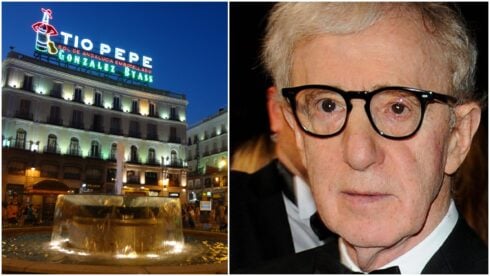As Isabel Pantoja – corruption suspect number 99 on the Operation Malaya list – returns to the stage while on bail, Lisa Tilley charts the rising and falling of a very Spanish survivor.
ON Saturday night, the grandiose plaza mayor in Valladolid began to fill with spectators from the early hours of the afternoon. More than 20,000 fans packed in shoulder to shoulder, bristling with anticipation, while the prime balconies over the square were rented for up to 6,000 euros each, for just a few hours.
Isabel Pantoja was the source of anticipation, the tonadillera (popular singer) who, whether performing or not, has always found herself centre stage in Spain. Just ten days before the Valladolid gig, she was looking somewhat less spectacular while being driven to the local police station. In this performance she played the protagonist in a dark drama of corruption and deceit, spending a night in the cells as part of Operación Malaya – the huge scale crackdown on town planning corruption in Marbella.But a life of leading roles had prepared Isabel for these most recent performances. In fact, it would be very difficult to find a woman who better encapsulates the numerous stereotypes of the Spanish female than La Pantoja. The persecuted gypsy girl, the formidable flamenco artist, the valiant matador’s wife, the grieving widow in black, the Marbella muse dripping in gold, lavished with corruption money and, ultimately the señora in trouble in the clutches of the arms of the law – Isabel has been every Spanish cliché at some stage in her tumultuous life.
A star is born
Isabel Pantoja was born on August 2, 1956, in the Seville barrio (area) of El Tardón, which skirts La Triana – the neighbourhood itself legendary for cultivating the greatest flamenco music of its day. During the 1950s, flamenco flowed through the very streets of La Triana as surely as the Guadalquivir flowed past it. As the centre of raw talent, the barrio was famous throughout the world for its streets, which rang with tonas, siguirias and soleas.
But the 1960s saw the heart of Triana extracted as Franco ordered the demolition of many of its residences and the exile of Seville’s gypsies to contained high rises away from town, known as Las Tres Mil. Instead of tocando palmas, Las Tres Mil now beats a rhythm of gun shots as rival drug gangs of gypsies fight amongst themselves.
The persecution of gypsies is a time-worn tale into which Isabel was born, but she was also born into the all consuming passion of flamenco. Her father Juan Pantoja, also known as Chiquetete, was part of Las Gaditanos a famous group of the 50s; her mother was a famed flamenco dancer. By the age of 7, she was on the stage at San Fernando theatre in Seville and at the age of 17 she found her big break. A performance in a tablao (flamenco club) in the 1970s was enough to attract Rafael de Leon and Juan Solano, the foremost flamenco composers of the day. From then, her internet adulators explain, the hits came rolling in and she became Spain’s crowned Reina de Copla (Queen of the Copla – the folkloric derivative of flamenco).
Mourning then Muñoz
Soon the queen was ready to collect her next title, as the novia (bride) of Spain. An egalitarian match, Pantoja married her equivalent weight in Spanish clichés: the epitome of machismo and virility in tight trousers – matador Francisco Rivera, known in the ring as Paquirri.
The matador and the gypsy virgin – the film Pedro Almodóvar should have made – danced down the aisle in the wedding of the year of 1983. Nine months later, Pantoja gave birth to a baby boy. Nine months after that, Paquirri was gored to death in Córdoba’s bull ring. Thus, Isabel morphed into her next guise as the viuda de España (the widow of Spain).
After a year of mourning, Pantoja returned to music with one of her most celebrated works, Marinero de Luces. She adopted a little girl, Isabelita, in 1995, but spent 13 years as a single widower, living up to her viuda de España label.
At the age of 40, however, she returned to the world of romance, announcing her relationship with ex-basketball star, Diego Gómez. The relationship faltered but Isabel had met a new lover: a man called Julián Muñoz.
Muñoz, the waiter turned local politician, was appointed by the late Jesús Gil (the spiritual architect of modern day Marbella) to take over responsibilities of public office while Gil lay low, entangled in his own web of corruption. Gil and Muñoz then had a bitter falling out – some believe because Gil despised Pantoja. However, Muñoz triumphed and finally assumed the position of mayor in 2003.
Then, it seemed Pantoja had been lucky in love at last. Hand in hand with Muñoz through the streets of Marbella, living in “Mi Gitana” (Muñoz’s pet name for their home on the exclusive La Pera urbanisation in the Costa del Sol resort), Isabel was selling out in concerts and records and charging 60,000 euros for brief public appearances. They had it all- but, it seemed, they wanted a little bit more and, in Marbella, there is always more to be had by people in high places.
Corruption crackdown
Then the police force opened a file marked Operación Malaya, and began an investigation into a corruption ring in Marbella that has so far seen over 100 people arrested, mainly former councillors and lawyers operating in the town.
One of the first to go to jail was Muñoz. And Mi Gitana has been rather empty since Pantoja’s beau was imprisoned, without bail, for money laundering and defrauding the treasury last July. A doe-eyed Isabel did all she could to retain public sympathy. On the television program Dónde Estás Corazon, she declared she felt she was “a victim” of Muñoz.
The law had other ideas: number ninety nine to be arrested for corrupt activities was the “victim,” Isabel Pantoja. On May 2, Pantoja was escorted from Mi Gitana while Muñoz watched the proceedings unfold from a grainy TV set in prison. The crime? Over two million unexplained euros had been paid into the Muñoz/Pantoja bank accounts without passing by the tax man first. There was also the question of their ill-gotten gains, namely apartment number 105 in the exclusive apartotel Guadalpín, their residence Mi Gitana and, more curiously, 300 cattle. One night in the cells and a 90,000 euro wedge of bail money and Isabel was free again, pending trial.
Ten days later, she embraced the night and 20,000 fans in Valladolid plaza mayor. Her fee for the occasion? The usual 60,000 euros and a rider of fresh coffee, cold sandwiches and a large mirror in which to arrange the frills of her train. It was also reported one spectator in particular was watching via a live connection from Valladolid to Jaén jail, watching La Pantoja, the gypsy, the queen and the criminal and for now, it seems, the survivor.
Click here to read more News from The Olive Press.






No he leido noticias en espanol por mucho tiempo .que sorpresa que la Viuda,Gitana la REINA de Espana este vinculada en un lio politice, personalmente yo no creo que es solo mala suerte que ella se haya relacionado con alguin como ese alcalce (MAYOR).
La senore Pantoja es un angel que transmite sus canciones con tanto sentimiento,con tanto que a sufrido la pobre dejenla en Pas.
Y alos que no les guste la senora para my y para muchos es la Reyna de Espana que dios la vendiga.
Dejen en paZ ALA PANTOJA EL PUEBLO LA ADORA